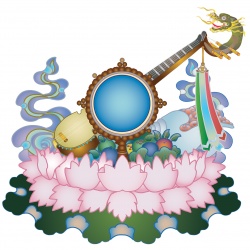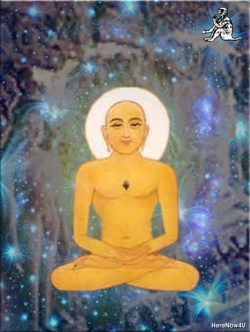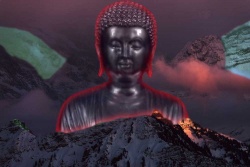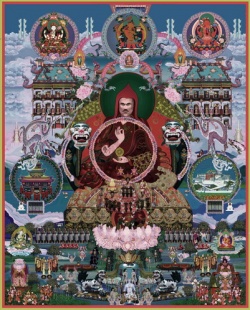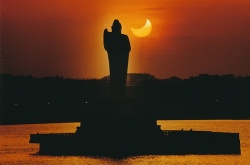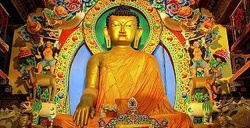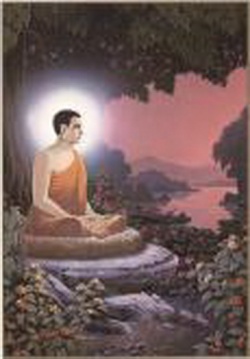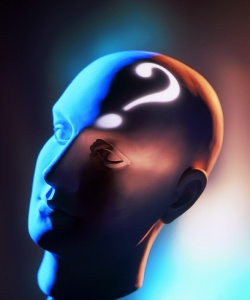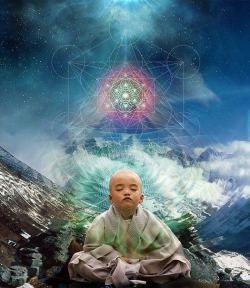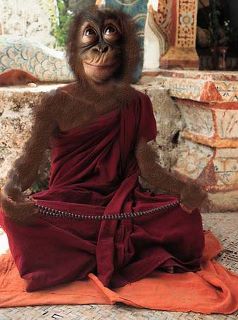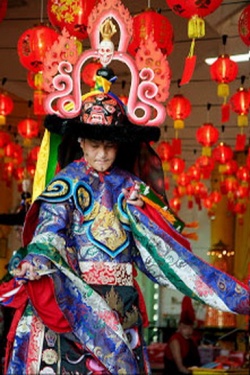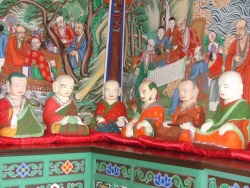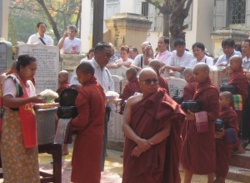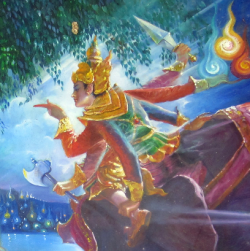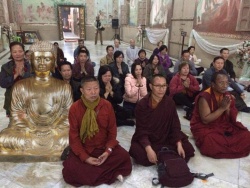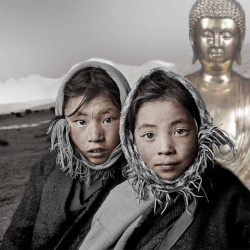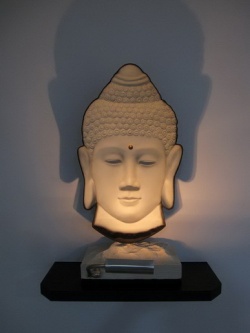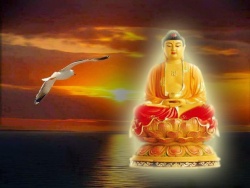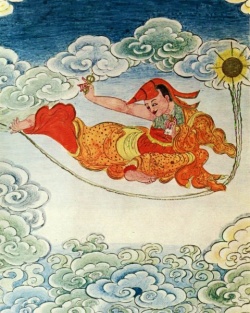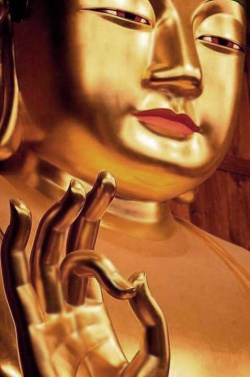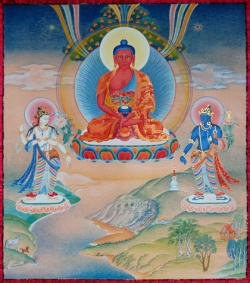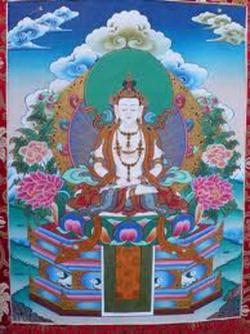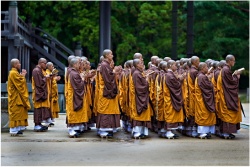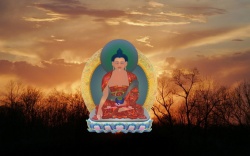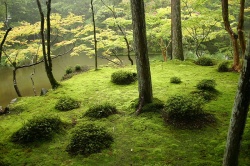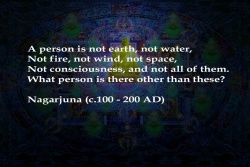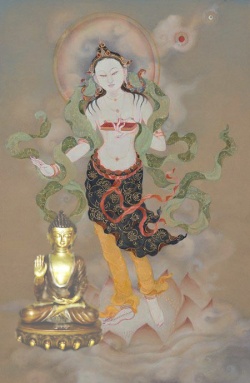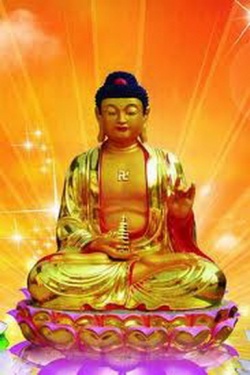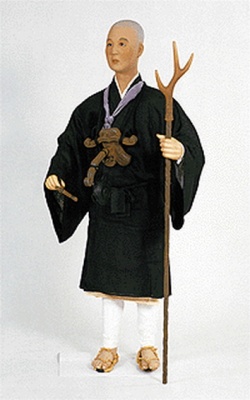Difference between revisions of "The Origin of the rGyud bzhi: A Tibetan Medical Tantra"
(Created page with " by Todd Fenner From Tibetan {{Wiki|Literature}}: Studies in Genre, pp. 458-469. Reproduced with permission from the author under the THL Digital Text License. Intro...") |
|||
| Line 1: | Line 1: | ||
| + | <nomobile>{{DisplayImages|1738|116|3938|463|166|418|4|967|2579|3945|1772|3260|2363|2207|3401|2538|3987|1740|4084|3079|3993|3776|212|1922|2618|2143|1983|3632|932|760|2547|4488|2016|499|2339}}</nomobile> | ||
| − | by Todd Fenner | + | |
| + | |||
| + | |||
| + | by [[Todd Fenner]] | ||
| Line 11: | Line 15: | ||
Introduction | Introduction | ||
| − | [page 458] The [[rGyud bzhi]] is the [[principal]] textbook of [[Tibetan medicine]]. It is cited frequently in almost all [[Tibetan medical]] {{Wiki|literature}} and is the text [[Tibetan medical]] students must [[master]] before becoming physicians. At the {{Wiki|Medical}} and [[Astrological]] Institute in {{Wiki|Dharamsala}}, all {{Wiki|medical}} students are expected to commit the text to [[memory]]; it is the foundation of their [[education]]. | + | [page 458] The [[rGyud bzhi]] is the [[principal]] textbook of [[Tibetan medicine]]. It is cited frequently in almost all [[Tibetan medical]] {{Wiki|literature}} and is the text [[Tibetan medical]] students must [[master]] before becoming physicians. |
| + | |||
| + | At the {{Wiki|Medical}} and [[Astrological]] Institute in {{Wiki|Dharamsala}}, all {{Wiki|medical}} students are expected to commit the text to [[memory]]; it is the foundation of their [[education]]. | ||
| − | |||
| − | While the [[rGyud bzhi]] is well known in the [[West]] among those [[interested]] in [[Tibetan medicine]], little is known of its history. All [[Tibetan]] writers have accepted the [[tradition]] that the [[rGyud bzhi]] is a translation of a [[Sanskrit]] {{Wiki|medical}} [[book]] entitled the | + | |
| + | The [[rGyud bzhi]] is also the most featured work in what little [[Western]] {{Wiki|literature}} there is concerning [[Tibetan medicine]].1 It was [[Csoma de Körös]] who introduced the [[book]] to the [[West]] through his extensive analysis of it in the January 1835 issue of the Journal of the {{Wiki|Royal Asiatic Society}}. | ||
| + | |||
| + | Since then, at least four partial translations of the [[book]] have appeared in the [[West]]: one in {{Wiki|Russian}}, by Peter [[Badmaev]] (1903); and three in English, by [[Rechung Rinpoche]] (1973), [[Jampa Kelsang]] ({{Wiki|Alan Wallace}}) (1976) and Terry Clifford (1984). | ||
| + | |||
| + | |||
| + | |||
| + | While the [[rGyud bzhi]] is well known in the [[West]] among those [[interested]] in [[Tibetan medicine]], little is known of its history. | ||
| + | |||
| + | All [[Tibetan]] writers have accepted the [[tradition]] that the [[rGyud bzhi]] is a translation of a [[Sanskrit]] {{Wiki|medical}} [[book]] entitled the [[Amṛṭahṛdayāṣṭaṅgaguhyopadeśa Tantra]] ("The [[Essence of Nectar]]: | ||
| + | |||
| + | The Manual of the [[Secret Teachings]] of the Eight Limbs") and have said no more, except for [[Rechung Rinpoche]], who has given a fuller account of the general history of [[medicine]] in [[Tibet]]. | ||
| + | |||
| + | This essay, then, examines the [[book's]] place in [[Tibetan medical]] {{Wiki|literature}}, the [[traditional]] history of the [[book]], the history of [[medicine]] at the time it was introduced, the work's style, and something about its contents, with a view to attempting an assessment of its origin. | ||
| + | |||
| + | Although we cannot treat all these topics in detail, some pertinent and [[interesting]] points can be made. | ||
Notes | Notes | ||
| Line 22: | Line 42: | ||
| − | The Place of the [[ | + | ==The [[Place of the rGyud bzhi in Tibetan Medical Literature]]== |
| + | |||
| + | |||
| + | |||
| + | Defining the range of [[Tibetan medical]] {{Wiki|literature}} depends directly on how one defines [[Tibetan medical]] practice. | ||
| + | |||
| + | If {{Wiki|medical}} practice encompasses those practices which are designed to improve or maintain [[mental]] and [[physical]] [[health]], then the range of {{Wiki|literature}} is quite vast. | ||
| + | |||
| + | One needs to include a wide assortment of [[religious]], [[ritual]], and [[yogic]] practices as well as various practices of {{Wiki|divination}}, [[amulet]] and talisman making, [[astrology]] and the like, in addition to the practices and theories that {{Wiki|modern}} {{Wiki|Western culture}} normally associates with the [[science]] of [[medicine]]. | ||
| + | |||
| + | |||
| + | |||
| + | The [[practice of medicine]] in [[Tibet]] is fully integrated with [[Tibetan]] [[religious]] [[views]] and practices. | ||
| + | |||
| + | [[Healing]] is a major task asked of many [[lamas]], and the different [[lineages]] each have [[rituals]] designed to accomplish this task. | ||
| + | |||
| + | These [[rituals]] usually involve the [[deities]] [[Bhaiṣajyaguru]], [[White Tārā]], and [[Amitāyus]] (associated most closely with [[medicine]] and long [[life]]), but may include other [[deities]] as well, such as [[Vajrasattva]], usually associated with the [[purification]] of [[negative karma]]. | ||
| + | |||
| + | In a popular {{Wiki|divination}} manual, now in English translation ([[Mipham]], 1990), the author usually recommends making [[offerings]] to a class of [[deities]] known as [[dharma protectors]] whenever an unfavorable {{Wiki|prognostication}} for {{Wiki|illness}} results after a toss of the dice. | ||
| + | |||
| + | However, it would be a mistake to think that the [[Tibetan]] [[religious]] {{Wiki|literature}} which pertains to [[healing]] is concerned only with [[ritual]]. | ||
| − | + | There are, scattered throughout [[tantric]] {{Wiki|literature}}, [[sections]] treating [[physiological]] {{Wiki|theory}}, [[physical]] {{Wiki|culture}}, and {{Wiki|pharmacology}} as well. | |
| − | + | This is true of both [[Wikipedia:canonical|canonical]] and post-canonical {{Wiki|literature}}.[page 460] The second [[chapter]] of the [[Kālacakra Tantra]], for instance, is entirely devoted to [[physiology]] and [[medicine]]. | |
| − | + | [[Medicine]] in the [[tantras]], however, is always secondary to the [[Wikipedia:Absolute (philosophy)|ultimate]] aim of achieving [[buddhahood]]. If it is addressed at all, [[medicine]] in the [[root tantras]] is clearly only a part of the whole. | |
| − | |||
| − | The | + | The {{Wiki|purpose}} of [[medicine]] in the genre of {{Wiki|literature}} that is termed [[gso ba rig pa]] (the [[science of medicine]]), though, is not [[enlightenment]], but the treatment of {{Wiki|disease}} and the maintenance of [[health]] through [[physical]] means. |
| − | Until the seventeenth century, [[Tibetan medicine]] was [[taught]] in [[monasteries]] as part of the [[worldly]] {{Wiki|sciences}}, and in [[lineages]] from {{Wiki|individual}} [[physician]] to [[disciple]]. The dominant [[lineages]] stemmed from the second gYu thog (eleventh century), a namesake of the first gYu thog (786-911?), who was closely connected with the [[transmission]] of the [[rGyud bzhi]] to [[Tibet]]. The second gYu thog wrote extensive commentaries on the [[rGyud bzhi]] and was responsible for giving the text its initial preeminence. In the fourteenth century two physicians, Byangs pa and Zur mkhar pa, each founded a {{Wiki|medical}} [[lineage]] based on that started by the second gYu thog. The [[rGyud bzhi]] became the [[principal]] text in each [[lineage]], and was the [[subject]] of a major commentary by each founder. In the late seventeenth century, sDe srid | + | [[Ritual]], the [[collection of merit]], the power of the [[lama]], etc. are never discounted, but the approach emphasizes therapies such as taking [[medicine]], eating properly, getting exercise or rest, and making [[lifestyle]] changes. |
| + | |||
| + | |||
| + | |||
| + | The [[rGyud bzhi]] can be considered as both the best-known work of this genre, and its {{Wiki|archetype}}. It is [[encyclopedic]] in scope, whereas other works of the genre tend to amplify one or more of the [[subjects]] it covers in briefer [[form]]. | ||
| + | |||
| + | Works on {{Wiki|pharmacology}}, {{Wiki|pediatrics}}, [[physiology]], diagnostics, etc., share with the [[rGyud bzhi]] the same general {{Wiki|theory}} of [[medicine]], and to my [[knowledge]] there are no works that dispute its premises. | ||
| + | |||
| + | |||
| + | Until the seventeenth century, [[Tibetan medicine]] was [[taught]] in [[monasteries]] as part of the [[worldly]] {{Wiki|sciences}}, and in [[lineages]] from {{Wiki|individual}} [[physician]] to [[disciple]]. | ||
| + | |||
| + | The dominant [[lineages]] stemmed from the second gYu thog (eleventh century), a namesake of the first [[gYu thog]] (786-911?), who was closely connected with the [[transmission]] of the [[rGyud bzhi]] to [[Tibet]]. | ||
| + | |||
| + | The second [[gYu thog]] wrote extensive commentaries on the [[rGyud bzhi]] and was responsible for giving the text its initial preeminence. | ||
| + | |||
| + | In the fourteenth century two physicians, Byangs pa and Zur mkhar pa, each founded a {{Wiki|medical}} [[lineage]] based on that started by the second [[gYu thog]]. | ||
| + | |||
| + | The [[rGyud bzhi]] became the [[principal]] text in each [[lineage]], and was the [[subject]] of a major commentary by each founder. | ||
| + | |||
| + | In the late seventeenth century, [[sDe srid Sangs rgyas rgya mtsho]], the {{Wiki|regent}} to the [[fifth Dalai Lama]], and holder of the [[lineages]] of both [[Byangs]] and [[Zur]], founded the [[first formal medical college in Tibet]], [[lCags po ri]], in [[Lhasa]]. | ||
| + | |||
| + | He also wrote what is probably the most influential commentary on the [[rGyud bzhi]], the [[Vaiḍūrya] sngon po]] ("[[Blue Lapis Lazuli]]"). Physicians trained at [[lCags po ri]] were sent to every [[district in Tibet]]. In this way the [[rGyud bzhi]] came to have a lasting and major effect on [[Tibetan medicine]].2[page 461] | ||
Notes | Notes | ||
| − | [2] My primary source for the historical events mentioned in this paragraph and the next section is lDe srid | + | [2] My primary source for the historical events mentioned in this paragraph and the next section is [[lDe srid Sangs rgyas rgya]] tsho]]'s [[History of Tibetan Medicine]], which, despite the title, is still in [[Tibetan]]. |
| + | |||
| + | For those who do not read [[Tibetan]], the best source I am {{Wiki|aware}} of is the introduction to [[Rechung]]. The {{Wiki|biography}} of the first [[gYu thog]], which is translated in that [[book]], is also a source. | ||
| + | |||
| + | |||
| + | |||
| + | ==The [[Origins of the rGyud bzhi]]== | ||
| + | |||
| + | |||
| + | |||
| + | There is a specific section in the [[bsTan 'gyur]] devoted to the translation of several [[Indian medical and pharmaceutical texts]] ([[gSo ba rig pa]]). | ||
| + | |||
| + | The [[rGyud bzhi]], however, is not found in the {{Wiki|medical}} section of the [[bsTan 'gyur]], nor, for that {{Wiki|matter}}, anywhere in the [[bKa' 'gyur]] or [[bsTan 'gyur]]. | ||
| + | |||
| + | The text does not belong to the [[canon]] because it is a [[gter ma]] (see [[Gyatso]], in this volume). | ||
| + | |||
| + | According to 'Dud '[[joms]] [[Rinpoche]], Grva pa [[mngon shes]] (1012-1090) discovered the text in a pillar of the middle story of the dBu rtse [[Temple]] of [[bSam yas]] [[Monastery]], at three a.m. on the [[full moon]] night of the seventh month of the year 1038 ('Dud '[[joms]], 1977: 95). | ||
| + | |||
| + | Its {{Wiki|status}} as a [[gter ma]] may have influenced the editors of the [[canon]] to question its authenticity as a translation of an [[Indic]] original. | ||
| + | |||
| + | This fact, however, did not deter any school from accepting the text as a basis for {{Wiki|medical}} practice. | ||
| + | |||
| + | In fact, the text is accepted as such by all [[lineages]], regardless of the disparaging remarks about [[gter ma]] in general that some of them may make. | ||
| + | |||
| + | |||
| + | There are a great many differences between the [[rGyud bzhi]] and the {{Wiki|medical}} [[books]] in the [[canon]]. | ||
| + | |||
| + | The [[Wikipedia:canonical|canonical]] [[books]] consist of the [[Yogaśataka]], the [[Jīvasūtra]], and the [[Avabheśajakalpa]], all attributed to the sage/adept [[Nāgārjuna]], and the [[Aṣṭaṅgahṛdaya]] by [[Vāgbhata]], his autocommentary to it, and two other commentaries to that work by [[Candranadana]]. | ||
| + | |||
| + | These works all have [[human]] authors, and fit the mold of classical [[Āyurvedic]] texts in style and content. | ||
| + | |||
| + | In fact, the [[Aṣṭaṅgahṛdaya]], written in the early seventh century by [[Vāgbhata]] at [[Nālandā]] [[Monastic College]], is considered to be one of the four most important texts of classical [[Indian]] [[medicine]], along with the [[Cāraka]], the [[Sūśrūta]] (also attributed to [[Nāgārjuna]]3), and the [[Mādhavanidāna]]. | ||
| + | |||
| + | |||
| + | |||
| + | Classical [[Āyurvedic]] texts are manuals consisting of {{Wiki|aphorisms}} and formula grouped under different headings, each heading being a unit unto itself that bears no necessary [[relation]] to the next one. They are also {{Wiki|secular}} works. | ||
| + | |||
| + | The names of [[sages]] and [[yogīs]] may be mentioned on occasion, but there is no [[religious]] position or {{Wiki|flavor}} to them. | ||
| + | |||
| + | The [[Cāraka]] and [[Sūśrūta]], both redaction's of earlier works, are organized in a manner that appears almost haphazard to the [[Western]] reader, being collections of {{Wiki|aphorisms}} containing both prose and verse. | ||
| + | |||
| + | Their authors and editors seem more concerned about preserving the [[integrity]] of an original aphorism[page 462] than in reworking them to fit into a more {{Wiki|uniform}} whole. | ||
| + | |||
| + | The [[Aṣṭaṅgahṛdaya]] and the [[Mādhavanidāna]], on the other hand, are much more consistent in style: one can read them without [[concern]] that the same [[subject]] might suddenly be dropped, only to be taken up again some fifty to a hundred pages later. | ||
| + | |||
| + | |||
| + | In terms of content, the classics are similar. | ||
| + | |||
| + | The [[Sūśrūta]] adds chapters on surgery and the Mādhavanidāna is concerned only with nosology and diagnosis, but all agree on a general {{Wiki|theory}} of [[medicine]] and [[physiology]]. | ||
| + | |||
| + | This {{Wiki|theory}}, in a nutshell, is as follows. | ||
| + | |||
| + | The [[human body]] has [[three humors]]—[[wind]], [[bile]], and [[phlegm]]4—which [[cause]] both [[physical]] and [[mental]] {{Wiki|disease}} if one or a combination of them gets out of [[balance]] with the others in a particular part of the [[body]]. | ||
| + | |||
| + | This [[balance]] is maintained or lost principally by a combination of [[lifestyle]], climate and the [[foods]] one eats, while treatment consists of making adjustments in these factors. | ||
| + | |||
| + | In [[Āyurveda]], prescriptions (with the exception of purgatives and emetics) do not act as [[drugs]], but rather as [[food]] supplements meant to restore [[balance]]. | ||
| + | |||
| + | Diagnosis consists primarily of taking a history and observing symptoms such as the {{Wiki|color}} of the {{Wiki|patient}} and so on. | ||
| + | |||
| + | |||
| + | |||
| + | The [[rGyud bzhi]] is {{Wiki|distinguished}} from classical [[Āyurvedic]] texts in several important ways. Perhaps the first thing one notices about the [[rGyud bzhi]] is that it is not a {{Wiki|secular}} {{Wiki|medical}} text at all. | ||
| + | |||
| + | After a few standard opening phrases, the text begins: "[[Thus have I heard]], at one time...," etc. In other words, the text begins in the style of a [[Buddhist sūtra]]. | ||
| + | |||
| + | The work is set in "[[Medicine City]]" ([[lTa na sdug]]), in the midst of a palace made from the five [[gems]]. | ||
| + | |||
| + | This city is free of all types of {{Wiki|diseases}} and is situated in the midst of a veritable [[medicine]] jungle of {{Wiki|fruits}}, herbs, [[roots]] and {{Wiki|minerals}}, while being pervaded by fragrant [[perfumes]]. | ||
| + | |||
| + | In the center of the palace, seated on a [[throne]] of [[lapis lazuli]], is the [[buddha]] [[Bhaiṣajyaguru]] (lit. "[[Medicine Teacher]]"), surrounded by a retinue of [[gods]], [[sages]], [[Buddhists]] and non-Buddhists. | ||
| + | |||
| + | Before [[teaching]], [[Bhaiṣajyaguru]] enters into the [[samādhi]] ([[concentration]] [[state]]) called "the [[king]] of {{Wiki|medicines}} which pacifies the four hundred and four {{Wiki|diseases}}." | ||
| + | |||
| + | |||
| + | |||
| + | Then, [[rays of light]], shining in hundreds of thousands of colors, [[emanate]] from his [[heart]] to the [[ten directions]]. | ||
| + | |||
| + | First they clear away faults from the [[minds]] of [[beings]], then they [[gather]] back and re-emanate as the [[Wikipedia:Sage (sophos|sage]] [[Rig pa'i ye shes]]. | ||
| + | |||
| + | [[Rig pa'i ye shes]] begins to speak to the assembly, first telling of the importance of the study of [[medicine]] and then starting a question-and-answer period, the contents of which make up the [[substance]] of the [[rGyud bzhi]].[page 463] | ||
| + | |||
| + | |||
| + | This opening is standard for most [[Mahāyāna sūtras]]. | ||
| + | |||
| + | |||
| + | |||
| + | First, a {{Wiki|witness}} states what has been heard (a reaffirmation of the [[oral lineage]]), describes those {{Wiki|present}} and the locale of the [[teaching]], and describes the various concentrations entered into prior to the dissemination of the [[teaching]]. | ||
| + | |||
| + | |||
| + | |||
| + | Here is also the clear identification of the [[Wikipedia:Sage (sophos|sage]] [[Rig pa'i ye shes]] as [[Bhaiṣajyaguru]]. | ||
| + | |||
| + | The different {{Wiki|retinues}} of [[Bhaiṣajyaguru]] heard different lectures, each according to their [[tradition]], [[faith]], and [[understanding]]. | ||
| + | |||
| + | The [[gods]] heard the text of the [[gSo dpyad 'bum pa]]; the [[Hindu]] [[sages]] heard the eight parts of the [[Cāraka]]; non-Buddhists heard the [[dBang phyug nag po'i rgyud]]; the [[Buddhists]] heard the [[Rigs gsum mgon pa'i skor]].5 | ||
| + | |||
| + | |||
| + | Also, for the [[benefit]] of [[beings]], in [[India]] the mixing of {{Wiki|medicines}} was [[taught]]; in [[China]], [[moxabustion]] and the taking of pulse; in Dol po, bleeding; in [[Tibet]], the {{Wiki|examination}} of {{Wiki|urine}} and pulse. | ||
| + | |||
| + | All this was transmitted without {{Wiki|distinction}} by [[Rig pa'i ye shes]], but again, the [[teaching]] was heard differently by [[beings]] of different propensities. | ||
| + | |||
| + | Only one [[Wikipedia:Sage (sophos|sage]], [[Yid las skyes]], heard the text the way it was really [[preached]]; he heard the "[[Essence of Nectar]]" in 5900 verses, the [[four tantras]], i.e., the [[rGyud bzhi]]. | ||
| + | |||
| + | |||
| + | [[Yid las skyes]], however, did not make his [[knowledge]] very accessible. Rather, after [[writing]] it down in lapis on a shield of solid {{Wiki|gold}}, he stored it with [[ḍākinīs]] in the land of [[Uḍḍiyāna]]. | ||
| + | |||
| + | |||
| + | For the {{Wiki|future}} {{Wiki|welfare}} of [[beings]], however, copies of the work were placed in leather boxes and put in several places. | ||
| + | |||
| + | |||
| + | The {{Wiki|forest}} of [[Vajrāsana]] ([[Bodhgaya]]) was one such place; also included were the secret rock {{Wiki|cave}} of the [[demi-gods]], [[Svayambhu]] in [[Nepal]], and a {{Wiki|cave}} in [[Go de shan]] in [[China]]. | ||
| + | |||
| + | |||
| + | |||
| + | The text is alleged to have arrived in [[Tibet]] during the reign of [[Khri srong lde'u btsan]], where it was translated by the [[scholar]] [[Vairocana]]. | ||
| + | |||
| + | |||
| + | After {{Wiki|learning}} [[Sanskrit]] from [[Padmasambhava]] and [[Śāntarakṣita]], [[Vairocana]] went to [[Kashmir]], where he studied under several [[scholars]], including [[Candranandana]], the commentator of the Aṣṭaṅgahṛdaya, from whom he learned the [[rGyud bzhi]]. | ||
| + | |||
| + | [[Vairocana]] returned to [[Tibet]] and [[offered]] the translation of this text to the [[king]]. | ||
| + | |||
| + | The [[rGyud bzhi]] was not propagated at this time, however, because [[Padmasambhava]] decided it would be more beneficial to hide the text. | ||
| + | |||
| + | This, according to legend, he did in the [[bum pa]] can ("vase-shaped") pillar of the middle story of the [[dBu rtse] [[Temple]] of [[bSam yas]], where it remained hidden until [[Grva pa mngon shes]] found it two hundred and fifty years later.[page 464] | ||
| + | |||
| + | |||
| + | The [[rGyud bzhi]], then, is considered a [[divine]] work, the original version of all {{Wiki|medical}} texts. | ||
| + | |||
| + | This is important to consider when hearing or reading [[traditional]] accounts of the text or the history of [[Tibetan medicine]], which place the work in a category with the other [[sūtras]] and [[tantras]]. Yet the [[rGyud bzhi]] does not read like a [[sūtra]] (or [[tantra]]), except in a few parts, such as the beginning. | ||
| + | |||
| + | The [[Medicine Buddha]] [[sūtras]], which one could rightfully claim as the [[sacred]] predecessors of the [[rGyud bzhi]], read like most [[Mahāyāna sūtras]], in which the order of the [[sections]] has little if any importance, and each new [[idea]] is embedded in a sort of repeating chorus, which was [[essential]] to the text's [[meditative]] or {{Wiki|mnemonic}} purposes. | ||
| + | |||
| + | Also, while many [[sūtras]] appear to be redactions and collections of [[oral traditions]] and [[visions]] occurring at different times, the [[rGyud bzhi]] is precisely organized and carefully scripted, more like a [[traditional]] śastra. | ||
| + | |||
| + | |||
| + | The [[first tantra]] of the [[rGyud bzhi]], the [[rTsa rgyud]] ("[[Root Manual]]") briefly sets forth a basis upon which an entire system can be built. | ||
| + | |||
| + | It gives [[essential]] phrases that cover the {{Wiki|medical}} system in brief and gives a {{Wiki|mnemonic}} device which provides a {{Wiki|structure}} for all that follows: the simile of a fig [[tree]], with its [[roots]], branches and leaves. | ||
| + | |||
| + | |||
| + | The [[second tantra]], the [[bShad rgyud]] ("[[Manual of Explanation]]"), expands and elucidates the {{Wiki|principles}} laid down in the [[rTsa rgyud]]. | ||
| + | |||
| + | |||
| + | The [[third tantra]], the [[Man ngag rgyud]] ("[[Manual of Precepts]]"), provides [[practical advice]] regarding treatment, with an explanation of different {{Wiki|diseases}}. | ||
| + | |||
| + | Finally, the [[fourth tantra]], the [[Phyi rgyud]] ("Appendix"), discusses different, more advanced methods of diagnosis and explains the preparation of {{Wiki|medicines}} as well as such methods as bloodletting. | ||
| + | |||
| + | |||
| + | The text is, as I have said, structured quite differently than a normal [[sūtra]] or [[tantra]]; it is also more systematically organized than the classical [[Āyurvedic]] texts. | ||
| + | |||
| + | One may contend that the [[Aṣṭaṅga-hṛdaya]] and [[Mādhavanidāna]] are also quite organized; but they are manuals, whereas the [[rGyud bzhi]] is a textbook. | ||
| + | |||
| + | The [[rGyud bzhi]] is not a collection, however well arranged, of {{Wiki|medical}} aphorisms—it is a work that has the plan of a written text. | ||
| + | |||
| + | |||
| + | This suggests that it was written at one time and if not by one [[person]], then by consensus. | ||
| + | |||
| + | It also suggests that it was not the product of a [[vision]] or [[yogic trance]], but of the [[rational]] [[mind-set of a [[scholar]]. | ||
| + | |||
| + | Even the {{Wiki|ecstatic}} [[vision]] described at the beginning is [[Wikipedia:Formula|formulaic]].[page 465] | ||
| + | |||
| + | |||
| + | |||
| + | In content the [[rGyud bzhi]] differs further from these [[Indian]] {{Wiki|medical}} texts: its [[exposition]] of {{Wiki|medical}} {{Wiki|theory}} and practice reveals some unique features. | ||
| + | |||
| + | The [[Āyurvedic]] texts list only four [[causes]] of disorder: [[wind]], {{Wiki|bile}}, [[phlegm]] and trauma. | ||
| + | |||
| + | Thus, all {{Wiki|diseases}} are classified as being either [[wind-born]], [[bile-born]], [[phlegm-born or some combination of these—"[[wind]]-[[bile]] {{Wiki|fever}}," for example. | ||
| + | |||
| + | The [[rGyud bzhi]] does not discard these categories—in fact, it uses them quite often and even relates the humors to the [[three poisons]] ([[lust]], [[anger]] and [[ignorance]])—but as far as {{Wiki|disease}} is concerned these three are subsumed under two broader classes, [[hot]] and cold. | ||
| + | |||
| + | The [[rGyud bzhi]] says that [[wind]] and [[phlegm]] are cold {{Wiki|diseases}}, while {{Wiki|blood}} and {{Wiki|bile}} are [[hot]] ones. | ||
| + | |||
| + | The inclusion here of {{Wiki|blood}} as a [[humor]] is also [[interesting]], for as the classes "[[hot]]" and "cold" are foreign to [[Āyurveda]], so is the inclusion of {{Wiki|blood}} among the humors. | ||
| + | |||
| + | To be fair, {{Wiki|blood}} is not always to be found in [[Tibetan]] lists of humors, but the fact that it is mentioned in the [[rGyud bzhi]] is significant. | ||
| + | |||
| + | |||
| + | |||
| + | With regard to methods of treatment and diagnosis, the [[rGyud bzhi]] also contains [[elements]] foreign to [[Āyurveda]]. | ||
| + | |||
| + | Briefly, these methods are the taking of pulse, [[moxabustion]], urinalysis and bloodletting. | ||
| + | |||
| + | The categories of [[hot]] and cold, the identification of {{Wiki|blood}} as a [[humor]], and the practice of bloodletting are all prime marks of classical {{Wiki|Greek}} [[medicine]], whereas pulse-taking and [[moxabustion]] are prime [[characteristics]] of {{Wiki|Chinese medicine}}. | ||
| + | |||
| + | To be sure, the way these practices and categories are used do not correspond exactly to {{Wiki|Greek}} and {{Wiki|Chinese}} systems. | ||
| + | |||
| + | For instance, the taking of pulse is more complex in the {{Wiki|Chinese}} system than in the [[Tibetan]]. There is [[reason]] to believe, however, that these similarities are more than coincidental. | ||
| + | [[Tibet]] may have been known in the {{Wiki|modern}} [[West]] as the "Forbidden Land," a model of isolation, but during the reigns of [[Srong btsan gam po]] and [[Khri srong lde'u btsan]], in the seventh and eighth centuries, the capital of [[Tibet]] was almost cosmopolitan. | ||
| − | + | Before [[Kri srong lde'u btsan]] committed [[Tibet]] to following an [[Indian]] cultural-religious model in preference to a {{Wiki|Chinese}} one, {{Wiki|Chinese}} [[views]] competed equally with the [[Indian]]. | |
| + | This was also true of [[medicine]]: physicians from several areas were invited to come to [[Lhasa]] to teach and translate what they knew. | ||
| + | [[Srong btsan sgam po]] is said to have invited three physicians to his court: [[Bharadrāja]] from [[India]], Han Wang Hang from [[China]], and [[Galenos]] from [[Persia]]. | ||
| − | + | [[Srong btsan sgam po's]] {{Wiki|Chinese}} [[Wikipedia:Queen consort|queen]] is also said to have brought with her from [[China]] a [[book]] entitled [[sMan dpyad chen mo]], which was translated by [[Hva shang]] [[Mahādeva]] and [[Dharmakoṣa]]. | |
| − | |||
| − | + | All three of these physicians [[taught]] and translated the various texts they brought, while the [[king]] had their teachings collected and disseminated. | |
| − | + | The official view was that if one did not study all three [[traditions]], one could not be considered a great [[physician]]. | |
| − | |||
| − | + | After the teachings had been given, the [[Indian]] and {{Wiki|Chinese}} [[doctors]] returned to their countries, but [[Galenos]], the [[Persian]], stayed on as [[Srong btsan sgam po's]] personal [[physician]], and continued to teach and write. | |
| − | + | He [[married]] a local women and fathered three children, who continued his {{Wiki|medical}} teachings. | |
| − | + | This type of {{Wiki|medical}} eclecticism continued through the reigns of succeeding [[kings]], who had [[Indian]] and {{Wiki|Chinese}} [[doctors]] in attendance. | |
| − | |||
| − | + | It also is important to remember that during the reign of [[King]] [[Kri srong lde'u btsan]], when the [[rGyud bzhi]] was supposedly brought into [[Tibet]] and hidden, the situation had not changed. | |
| − | + | [[Lhasa]] had remained a melting pot of the {{Wiki|medical}} [[traditions]]. At [[Khri srong lde'u btsan's]] court were [[Śāntigarbha]] from [[India]]; | |
| − | + | [[Guhyavajra]] from [[Kashmir]]; [[sTong gsum gang ba]], [[Ha shab bal la]], and [[Hang ti pa ta]] from [[China]]; [[Halashanti]] from [[Persia]]; [[Seng mdo 'od chen]] from Grugu; [[Kyal ma ruci]] from [[Dol po]]; and [[Dharmasala]] from [[Nepal]]. All of them [[taught]] [[medicine]] and translated texts. | |
| − | |||
| − | |||
| − | |||
| − | |||
Notes | Notes | ||
| − | [3] It is [[interesting]] that an extant work of this stature, attributed to [[Nāgārjuna]], does not seem to have been brought to [[Tibet]], while some comparatively very minor works were. This fact may provide a clue as to its real date, as well as shed {{Wiki|light}} on the different [[Nāgārjuna]] {{Wiki|legends}} in [[India]]. | + | |
| + | |||
| + | [3] It is [[interesting]] that an extant work of this stature, attributed to [[Nāgārjuna]], does not seem to have been brought to [[Tibet]], while some comparatively very minor works were. | ||
| + | |||
| + | This fact may provide a clue as to its real date, as well as shed {{Wiki|light}} on the different [[Nāgārjuna]] {{Wiki|legends}} in [[India]]. | ||
[4] | [4] | ||
| − | The role of humors in [[Indic]] [[medicine]] is similar to that in classical [[Western medicine]]; however, the | + | The role of [[humors]] in [[Indic]] [[medicine]] is similar to that in classical [[Western medicine]]; however, the [[humors]] themselves differ. |
| − | In [[Indic]] {{Wiki|theory}}, {{Wiki|bile}} is responsible for heat, {{Wiki|digestion}}, the [[emotion]] of [[anger]], and other functions. [[Phlegm]] counterbalances the heat of {{Wiki|bile}} and provides the [[body]] with {{Wiki|firmness}}. [[Wind]] not only refers to [[breath]] and abdominal gas, but also is seen as the [[vehicle]] of [[thoughts]] and [[life]]. | + | In the [[West]], there are four—blood, black {{Wiki|bile}}, [[yellow]] {{Wiki|bile}}, and [[phlegm]]. |
| − | [5] Except for the fairly obvious reference to the Cāraka Saṃhitā, the other titles refer to works I have never seen.[page 468] | + | |
| + | The [[Indic]] [[humors]] {{Wiki|bile}} and [[phlegm]] correspond quite closely to the [[yellow]] {{Wiki|bile}} and [[phlegm]] of [[Western]] {{Wiki|theory}}. | ||
| + | |||
| + | The third [[Indic]] [[humor]], [[wind]], has no counterpart in [[Western medicine]]. | ||
| + | |||
| + | |||
| + | In [[Indic]] {{Wiki|theory}}, {{Wiki|bile}} is responsible for heat, {{Wiki|digestion}}, the [[emotion]] of [[anger]], and other functions. | ||
| + | |||
| + | [[Phlegm]] counterbalances the heat of {{Wiki|bile}} and provides the [[body]] with {{Wiki|firmness}}. | ||
| + | |||
| + | [[Wind]] not only refers to [[breath]] and abdominal gas, but also is seen as the [[vehicle]] of [[thoughts]] and [[life]]. | ||
| + | |||
| + | [5] Except for the fairly obvious reference to the [[Cāraka Saṃhitā]], the other titles refer to works I have never seen.[page 468] | ||
| Line 92: | Line 352: | ||
Conclusion | Conclusion | ||
| − | If there was any place where a textbook blending the {{Wiki|medical}} [[traditions]] of {{Wiki|Greece}}, [[India]], and [[China]] would be expected to originate, it would be [[Tibet]]. The {{Wiki|hypothesis}} that the [[rGyud bzhi]] is a translation of a [[Sanskrit]] {{Wiki|medical}} work is an unlikely one. It differs too much in both style and content from related [[Indian]] works for this {{Wiki|hypothesis}} to be credible. Too, the fact that the work is not mentioned in any other [[Sanskrit]] {{Wiki|medical}} text must be accounted for. Even [[Candranandana]], who supposedly [[taught]] the text to [[Vairocana]], seems oblivious to its [[existence]] in his commentaries to the Aṣṭaṅgahṛdaya. It is likely that the [[rGyud bzhi]] is a native [[Tibetan]] | + | If there was any place where a textbook blending the {{Wiki|medical}} [[traditions]] of {{Wiki|Greece}}, [[India]], and [[China]] would be expected to originate, it would be [[Tibet]]. |
| + | |||
| + | The {{Wiki|hypothesis}} that the [[rGyud bzhi]] is a translation of a [[Sanskrit]] {{Wiki|medical}} work is an unlikely one. It differs too much in both style and content from related [[Indian]] works for this {{Wiki|hypothesis}} to be credible. | ||
| + | |||
| + | Too, the fact that the work is not mentioned in any other [[Sanskrit]] {{Wiki|medical}} text must be accounted for. | ||
| + | |||
| + | Even [[Candranandana]], who supposedly [[taught]] the text to [[Vairocana]], seems oblivious to its [[existence]] in his commentaries to the [[Aṣṭaṅgahṛdaya]]. | ||
| + | |||
| + | It is likely that the [[rGyud bzhi]] is a native [[Tibetan text]], certainly [[Buddhist]], mainly [[Indian]] in its influence, but with strong [[elements]] of {{Wiki|Chinese}} and {{Wiki|Greek}} [[traditions]] as well. | ||
| + | |||
In summary, the [[rGyud bzhi]] appears to be a native [[Tibetan]] work, written at a time when the [[traditions]] of [[India]], [[China]] and {{Wiki|Greece}} met and blended together within a [[Buddhist]] framework.[page 467] | In summary, the [[rGyud bzhi]] appears to be a native [[Tibetan]] work, written at a time when the [[traditions]] of [[India]], [[China]] and {{Wiki|Greece}} met and blended together within a [[Buddhist]] framework.[page 467] | ||
| − | One {{Wiki|modern}} [[Tibetan]] writer ([[Tsarong]], 1981: 93-94), reports a [[belief]] that the second gYu thog heavily revised the [[rGyud bzhi]], and that this may account for the differences between it and [[traditional]] [[Indian]] works. This may be true, but the original text found by Grva pa | + | One {{Wiki|modern}} [[Tibetan]] writer ([[Tsarong]], 1981: 93-94), reports a [[belief]] that the second [[gYu thog]] heavily revised the [[rGyud bzhi]], and that this may account for the differences between it and [[traditional]] [[Indian]] works. |
| + | |||
| + | This may be true, but the original text found by [[Grva pa mngon shes]] was presumably still in [[existence]] at least through 1959. | ||
| + | |||
| + | I would assume that if it was, and the second [[gYu thog]] radically changed the work, this [[belief]] would have become far more widespread than it has. | ||
| + | |||
| + | I think it far more likely that the original [[gYu thog]] wove the various [[traditions]] together using [[Indian]] works, perhaps the [[Aṣṭaṅgahṛdaya]], to [[form]] the [[rGyud bzhi]] as it was found at [[bSam yas]]. | ||
| + | |||
| + | Because of [[Tibetan]] reverence for things [[Indian]], and perhaps because the work was written under the inspiration of [[Bhaiṣajyaguru]], the {{Wiki|Chinese}} and {{Wiki|Greek}} [[traditions]] were not given credit for their part in the work. | ||
| + | |||
| + | In any case, the text came to be considered a secret [[Indian]] work revealed for the [[benefit]] of [[sentient beings]]. | ||
| Line 103: | Line 382: | ||
[[Badmaev]], Peter | [[Badmaev]], Peter | ||
| − | + | 1903 Glavnoe rkovodsva po vrochehnoi naukie [[Tibeta]] [[Zhud Zhi]]. {{Wiki|St. Petersburg}}. | |
| − | [[bDud | + | [[bDud 'joms Rin po che]] |
| − | + | 1977 Hagiography of [[gRva pa mngon shes]], the discoverer of the famous {{Wiki|medical}} work [[rGyud bzhi]]. From [[rNying ma'i chos byung]]. In The Rise of [[Esoteric Buddhism]] in [[Tibet]], pp. 94-96. Trans. by Eva M. [[Dargyay]]. {{Wiki|Delhi}}: Motilal Banarasidass. | |
Cāraka | Cāraka | ||
| − | + | 1963 [[Cāraka Saṃhitā]]. Edited with {{Wiki|Hindi}} commentary by [[Jayadeva]] Vidhyalankara. {{Wiki|Delhi}}: {{Wiki|Motilal Banarsidass}}. | |
Clifford, Terry | Clifford, Terry | ||
| − | + | 1984 [[Tibetan Buddhist Medicine]] and Psychiatry. York Beach, Maine: Samuel Weiser. | |
g.Yu thog pa | g.Yu thog pa | ||
| − | + | 1968 [[Yuthok's]] Treatise on [[Tibetan Medicine]]. Edited by [[Lokesh Chandra]]. {{Wiki|Delhi}}: International {{Wiki|Academy}} of {{Wiki|Indian Culture}}. | |
[[Kālacakra Tantra]] | [[Kālacakra Tantra]] | ||
| − | + | 1958 [[Paramādibuddhaśrīkālacakranāmatantrarāja]]. P no. 4, vol. 1, pp. 127.4.1-175.1.1. | |
Kelsang, [[Jampa]], trans. | Kelsang, [[Jampa]], trans. | ||
| − | + | 1976 The [[Ambrosia Heart Tantra]]. {{Wiki|Dharamsala}}: {{Wiki|Library of Tibetan Works and Archives}}. | |
Körös, A. Csoma de | Körös, A. Csoma de | ||
| − | + | 1835 Analysis of a [[Tibetan Medical]] Work.[[Journal of the Asiatic Society of Bengal]] (Jan. 1835), pp. 1-20. | |
lDe srid [[Sangs rgyas]] [[rgya]] mthso | lDe srid [[Sangs rgyas]] [[rgya]] mthso | ||
| − | + | 1975 History of [[Tibetan Medicine]] ([[gSo rigs khog 'bugs legs shad bai dur ya me long]]). Leh: Tashigangpa. | |
| − | + | 1974 [[gSo ba rig pa'i bstan bcos sman bla'i dgongs rgyan rgyud bzhi'i gsal byed bai dur sngon po'i ma lli ka]]. 4 vols. Leh: Tashigangpa. | |
[[Mādhava]] | [[Mādhava]] | ||
| − | + | 1954 [[Mādhavanidāna]]. Ed. by Brahmashankar Shastri. [[Varanasi]]: Chowkambha [[Sanskrit]] Series. | |
[[Mipham]] | [[Mipham]] | ||
| − | + | 1990 MO, [[Tibetan Divination System]]. Trans. by Jay Goldbergand Lobsang [[Dakpa]]. [[Ithaca]]: [[Snow Lion]].[page 469] | |
[[Rechung Rinpoche]] | [[Rechung Rinpoche]] | ||
| − | + | 1973 [[Tibetan Medicine]]. [[Berkeley]]: {{Wiki|University of California Press}}. | |
[[rGyud bzhi]] | [[rGyud bzhi]] | ||
| − | + | 1975 [[rGyud bzhi]]. Leh: Tashigangpa. | |
Sūśrūta | Sūśrūta | ||
| − | + | 1967 [[Sūśrūta Saṃhīta]]. Ed. by Sri Lalacandra [[Vaidya]] et al. {{Wiki|Delhi}}: {{Wiki|Motilal Banarsidass}}. | |
[[Tsarong]], T. J. | [[Tsarong]], T. J. | ||
| − | + | 1981 Fundamentals of [[Tibetan Medicine]]. {{Wiki|Dharamsala}}: [[Tibetan Medical Centre]]. | |
[[Vagbhata]] | [[Vagbhata]] | ||
| − | + | 1959 [[Aṣṭaṅgahṛdayam]]. Ed. by Yaunanand [[Upadhyaya]]. [[Varanasi]]: Chowkhamba [[Sanskrit]] Series. | |
| − | + | 1962 [[Aṣṭaṅgasaṃgrāha]]. Ed. by Atridava [[Gupta]]. {{Wiki|Bombay}}: Nirnagsagar Mudranalaga. | |
{{R}} | {{R}} | ||
http://www.thlib.org/encyclopedias/literary/genres/genres-book.php#!book=/studies-in-genres/b27/dn1/ | http://www.thlib.org/encyclopedias/literary/genres/genres-book.php#!book=/studies-in-genres/b27/dn1/ | ||
[[Category:Tibetan medicine]] | [[Category:Tibetan medicine]] | ||
Revision as of 00:51, 30 November 2015
by Todd Fenner
From Tibetan Literature: Studies in Genre, pp. 458-469.
Reproduced with permission from the author under the THL Digital Text License.
Introduction
[page 458] The rGyud bzhi is the principal textbook of Tibetan medicine. It is cited frequently in almost all Tibetan medical literature and is the text Tibetan medical students must master before becoming physicians.
At the Medical and Astrological Institute in Dharamsala, all medical students are expected to commit the text to memory; it is the foundation of their education.
The rGyud bzhi is also the most featured work in what little Western literature there is concerning Tibetan medicine.1 It was Csoma de Körös who introduced the book to the West through his extensive analysis of it in the January 1835 issue of the Journal of the Royal Asiatic Society.
Since then, at least four partial translations of the book have appeared in the West: one in Russian, by Peter Badmaev (1903); and three in English, by Rechung Rinpoche (1973), Jampa Kelsang (Alan Wallace) (1976) and Terry Clifford (1984).
While the rGyud bzhi is well known in the West among those interested in Tibetan medicine, little is known of its history.
All Tibetan writers have accepted the tradition that the rGyud bzhi is a translation of a Sanskrit medical book entitled the Amṛṭahṛdayāṣṭaṅgaguhyopadeśa Tantra ("The Essence of Nectar:
The Manual of the Secret Teachings of the Eight Limbs") and have said no more, except for Rechung Rinpoche, who has given a fuller account of the general history of medicine in Tibet.
This essay, then, examines the book's place in Tibetan medical literature, the traditional history of the book, the history of medicine at the time it was introduced, the work's style, and something about its contents, with a view to attempting an assessment of its origin.
Although we cannot treat all these topics in detail, some pertinent and interesting points can be made. Notes
[1] A good list of Tibetan medical works can be found in the appendix of Tsarong. A bibliography of Western books and articles (up to 1973) on the subject can be found in Rechung.
The Place of the rGyud bzhi in Tibetan Medical Literature
Defining the range of Tibetan medical literature depends directly on how one defines Tibetan medical practice.
If medical practice encompasses those practices which are designed to improve or maintain mental and physical health, then the range of literature is quite vast.
One needs to include a wide assortment of religious, ritual, and yogic practices as well as various practices of divination, amulet and talisman making, astrology and the like, in addition to the practices and theories that modern Western culture normally associates with the science of medicine.
The practice of medicine in Tibet is fully integrated with Tibetan religious views and practices.
Healing is a major task asked of many lamas, and the different lineages each have rituals designed to accomplish this task.
These rituals usually involve the deities Bhaiṣajyaguru, White Tārā, and Amitāyus (associated most closely with medicine and long life), but may include other deities as well, such as Vajrasattva, usually associated with the purification of negative karma.
In a popular divination manual, now in English translation (Mipham, 1990), the author usually recommends making offerings to a class of deities known as dharma protectors whenever an unfavorable prognostication for illness results after a toss of the dice.
However, it would be a mistake to think that the Tibetan religious literature which pertains to healing is concerned only with ritual.
There are, scattered throughout tantric literature, sections treating physiological theory, physical culture, and pharmacology as well.
This is true of both canonical and post-canonical literature.[page 460] The second chapter of the Kālacakra Tantra, for instance, is entirely devoted to physiology and medicine.
Medicine in the tantras, however, is always secondary to the ultimate aim of achieving buddhahood. If it is addressed at all, medicine in the root tantras is clearly only a part of the whole.
The purpose of medicine in the genre of literature that is termed gso ba rig pa (the science of medicine), though, is not enlightenment, but the treatment of disease and the maintenance of health through physical means.
Ritual, the collection of merit, the power of the lama, etc. are never discounted, but the approach emphasizes therapies such as taking medicine, eating properly, getting exercise or rest, and making lifestyle changes.
The rGyud bzhi can be considered as both the best-known work of this genre, and its archetype. It is encyclopedic in scope, whereas other works of the genre tend to amplify one or more of the subjects it covers in briefer form.
Works on pharmacology, pediatrics, physiology, diagnostics, etc., share with the rGyud bzhi the same general theory of medicine, and to my knowledge there are no works that dispute its premises.
Until the seventeenth century, Tibetan medicine was taught in monasteries as part of the worldly sciences, and in lineages from individual physician to disciple.
The dominant lineages stemmed from the second gYu thog (eleventh century), a namesake of the first gYu thog (786-911?), who was closely connected with the transmission of the rGyud bzhi to Tibet.
The second gYu thog wrote extensive commentaries on the rGyud bzhi and was responsible for giving the text its initial preeminence.
In the fourteenth century two physicians, Byangs pa and Zur mkhar pa, each founded a medical lineage based on that started by the second gYu thog.
The rGyud bzhi became the principal text in each lineage, and was the subject of a major commentary by each founder.
In the late seventeenth century, sDe srid Sangs rgyas rgya mtsho, the regent to the fifth Dalai Lama, and holder of the lineages of both Byangs and Zur, founded the first formal medical college in Tibet, lCags po ri, in Lhasa.
He also wrote what is probably the most influential commentary on the rGyud bzhi, the [[Vaiḍūrya] sngon po]] ("Blue Lapis Lazuli"). Physicians trained at lCags po ri were sent to every district in Tibet. In this way the rGyud bzhi came to have a lasting and major effect on Tibetan medicine.2[page 461]
Notes
[2] My primary source for the historical events mentioned in this paragraph and the next section is lDe srid Sangs rgyas rgya tsho]]'s History of Tibetan Medicine, which, despite the title, is still in Tibetan.
For those who do not read Tibetan, the best source I am aware of is the introduction to Rechung. The biography of the first gYu thog, which is translated in that book, is also a source.
The Origins of the rGyud bzhi
There is a specific section in the bsTan 'gyur devoted to the translation of several Indian medical and pharmaceutical texts (gSo ba rig pa).
The rGyud bzhi, however, is not found in the medical section of the bsTan 'gyur, nor, for that matter, anywhere in the bKa' 'gyur or bsTan 'gyur.
The text does not belong to the canon because it is a gter ma (see Gyatso, in this volume).
According to 'Dud 'joms Rinpoche, Grva pa mngon shes (1012-1090) discovered the text in a pillar of the middle story of the dBu rtse Temple of bSam yas Monastery, at three a.m. on the full moon night of the seventh month of the year 1038 ('Dud 'joms, 1977: 95).
Its status as a gter ma may have influenced the editors of the canon to question its authenticity as a translation of an Indic original.
This fact, however, did not deter any school from accepting the text as a basis for medical practice.
In fact, the text is accepted as such by all lineages, regardless of the disparaging remarks about gter ma in general that some of them may make.
There are a great many differences between the rGyud bzhi and the medical books in the canon.
The canonical books consist of the Yogaśataka, the Jīvasūtra, and the Avabheśajakalpa, all attributed to the sage/adept Nāgārjuna, and the Aṣṭaṅgahṛdaya by Vāgbhata, his autocommentary to it, and two other commentaries to that work by Candranadana.
These works all have human authors, and fit the mold of classical Āyurvedic texts in style and content.
In fact, the Aṣṭaṅgahṛdaya, written in the early seventh century by Vāgbhata at Nālandā Monastic College, is considered to be one of the four most important texts of classical Indian medicine, along with the Cāraka, the Sūśrūta (also attributed to Nāgārjuna3), and the Mādhavanidāna.
Classical Āyurvedic texts are manuals consisting of aphorisms and formula grouped under different headings, each heading being a unit unto itself that bears no necessary relation to the next one. They are also secular works.
The names of sages and yogīs may be mentioned on occasion, but there is no religious position or flavor to them.
The Cāraka and Sūśrūta, both redaction's of earlier works, are organized in a manner that appears almost haphazard to the Western reader, being collections of aphorisms containing both prose and verse.
Their authors and editors seem more concerned about preserving the integrity of an original aphorism[page 462] than in reworking them to fit into a more uniform whole.
The Aṣṭaṅgahṛdaya and the Mādhavanidāna, on the other hand, are much more consistent in style: one can read them without concern that the same subject might suddenly be dropped, only to be taken up again some fifty to a hundred pages later.
In terms of content, the classics are similar.
The Sūśrūta adds chapters on surgery and the Mādhavanidāna is concerned only with nosology and diagnosis, but all agree on a general theory of medicine and physiology.
This theory, in a nutshell, is as follows.
The human body has three humors—wind, bile, and phlegm4—which cause both physical and mental disease if one or a combination of them gets out of balance with the others in a particular part of the body.
This balance is maintained or lost principally by a combination of lifestyle, climate and the foods one eats, while treatment consists of making adjustments in these factors.
In Āyurveda, prescriptions (with the exception of purgatives and emetics) do not act as drugs, but rather as food supplements meant to restore balance.
Diagnosis consists primarily of taking a history and observing symptoms such as the color of the patient and so on.
The rGyud bzhi is distinguished from classical Āyurvedic texts in several important ways. Perhaps the first thing one notices about the rGyud bzhi is that it is not a secular medical text at all.
After a few standard opening phrases, the text begins: "Thus have I heard, at one time...," etc. In other words, the text begins in the style of a Buddhist sūtra.
The work is set in "Medicine City" (lTa na sdug), in the midst of a palace made from the five gems.
This city is free of all types of diseases and is situated in the midst of a veritable medicine jungle of fruits, herbs, roots and minerals, while being pervaded by fragrant perfumes.
In the center of the palace, seated on a throne of lapis lazuli, is the buddha Bhaiṣajyaguru (lit. "Medicine Teacher"), surrounded by a retinue of gods, sages, Buddhists and non-Buddhists.
Before teaching, Bhaiṣajyaguru enters into the samādhi (concentration state) called "the king of medicines which pacifies the four hundred and four diseases."
Then, rays of light, shining in hundreds of thousands of colors, emanate from his heart to the ten directions.
First they clear away faults from the minds of beings, then they gather back and re-emanate as the sage Rig pa'i ye shes.
Rig pa'i ye shes begins to speak to the assembly, first telling of the importance of the study of medicine and then starting a question-and-answer period, the contents of which make up the substance of the rGyud bzhi.[page 463]
This opening is standard for most Mahāyāna sūtras.
First, a witness states what has been heard (a reaffirmation of the oral lineage), describes those present and the locale of the teaching, and describes the various concentrations entered into prior to the dissemination of the teaching.
Here is also the clear identification of the sage Rig pa'i ye shes as Bhaiṣajyaguru.
The different retinues of Bhaiṣajyaguru heard different lectures, each according to their tradition, faith, and understanding.
The gods heard the text of the gSo dpyad 'bum pa; the Hindu sages heard the eight parts of the Cāraka; non-Buddhists heard the dBang phyug nag po'i rgyud; the Buddhists heard the Rigs gsum mgon pa'i skor.5
Also, for the benefit of beings, in India the mixing of medicines was taught; in China, moxabustion and the taking of pulse; in Dol po, bleeding; in Tibet, the examination of urine and pulse.
All this was transmitted without distinction by Rig pa'i ye shes, but again, the teaching was heard differently by beings of different propensities.
Only one sage, Yid las skyes, heard the text the way it was really preached; he heard the "Essence of Nectar" in 5900 verses, the four tantras, i.e., the rGyud bzhi.
Yid las skyes, however, did not make his knowledge very accessible. Rather, after writing it down in lapis on a shield of solid gold, he stored it with ḍākinīs in the land of Uḍḍiyāna.
For the future welfare of beings, however, copies of the work were placed in leather boxes and put in several places.
The forest of Vajrāsana (Bodhgaya) was one such place; also included were the secret rock cave of the demi-gods, Svayambhu in Nepal, and a cave in Go de shan in China.
The text is alleged to have arrived in Tibet during the reign of Khri srong lde'u btsan, where it was translated by the scholar Vairocana.
After learning Sanskrit from Padmasambhava and Śāntarakṣita, Vairocana went to Kashmir, where he studied under several scholars, including Candranandana, the commentator of the Aṣṭaṅgahṛdaya, from whom he learned the rGyud bzhi.
Vairocana returned to Tibet and offered the translation of this text to the king.
The rGyud bzhi was not propagated at this time, however, because Padmasambhava decided it would be more beneficial to hide the text.
This, according to legend, he did in the bum pa can ("vase-shaped") pillar of the middle story of the [[dBu rtse] Temple of bSam yas, where it remained hidden until Grva pa mngon shes found it two hundred and fifty years later.[page 464]
The rGyud bzhi, then, is considered a divine work, the original version of all medical texts.
This is important to consider when hearing or reading traditional accounts of the text or the history of Tibetan medicine, which place the work in a category with the other sūtras and tantras. Yet the rGyud bzhi does not read like a sūtra (or tantra), except in a few parts, such as the beginning.
The Medicine Buddha sūtras, which one could rightfully claim as the sacred predecessors of the rGyud bzhi, read like most Mahāyāna sūtras, in which the order of the sections has little if any importance, and each new idea is embedded in a sort of repeating chorus, which was essential to the text's meditative or mnemonic purposes.
Also, while many sūtras appear to be redactions and collections of oral traditions and visions occurring at different times, the rGyud bzhi is precisely organized and carefully scripted, more like a traditional śastra.
The first tantra of the rGyud bzhi, the rTsa rgyud ("Root Manual") briefly sets forth a basis upon which an entire system can be built.
It gives essential phrases that cover the medical system in brief and gives a mnemonic device which provides a structure for all that follows: the simile of a fig tree, with its roots, branches and leaves.
The second tantra, the bShad rgyud ("Manual of Explanation"), expands and elucidates the principles laid down in the rTsa rgyud.
The third tantra, the Man ngag rgyud ("Manual of Precepts"), provides practical advice regarding treatment, with an explanation of different diseases.
Finally, the fourth tantra, the Phyi rgyud ("Appendix"), discusses different, more advanced methods of diagnosis and explains the preparation of medicines as well as such methods as bloodletting.
The text is, as I have said, structured quite differently than a normal sūtra or tantra; it is also more systematically organized than the classical Āyurvedic texts.
One may contend that the Aṣṭaṅga-hṛdaya and Mādhavanidāna are also quite organized; but they are manuals, whereas the rGyud bzhi is a textbook.
The rGyud bzhi is not a collection, however well arranged, of medical aphorisms—it is a work that has the plan of a written text.
This suggests that it was written at one time and if not by one person, then by consensus.
It also suggests that it was not the product of a vision or yogic trance, but of the rational [[mind-set of a scholar.
Even the ecstatic vision described at the beginning is formulaic.[page 465]
In content the rGyud bzhi differs further from these Indian medical texts: its exposition of medical theory and practice reveals some unique features.
The Āyurvedic texts list only four causes of disorder: wind, bile, phlegm and trauma.
Thus, all diseases are classified as being either wind-born, bile-born, [[phlegm-born or some combination of these—"wind-bile fever," for example.
The rGyud bzhi does not discard these categories—in fact, it uses them quite often and even relates the humors to the three poisons (lust, anger and ignorance)—but as far as disease is concerned these three are subsumed under two broader classes, hot and cold.
The rGyud bzhi says that wind and phlegm are cold diseases, while blood and bile are hot ones.
The inclusion here of blood as a humor is also interesting, for as the classes "hot" and "cold" are foreign to Āyurveda, so is the inclusion of blood among the humors.
To be fair, blood is not always to be found in Tibetan lists of humors, but the fact that it is mentioned in the rGyud bzhi is significant.
With regard to methods of treatment and diagnosis, the rGyud bzhi also contains elements foreign to Āyurveda.
Briefly, these methods are the taking of pulse, moxabustion, urinalysis and bloodletting.
The categories of hot and cold, the identification of blood as a humor, and the practice of bloodletting are all prime marks of classical Greek medicine, whereas pulse-taking and moxabustion are prime characteristics of Chinese medicine.
To be sure, the way these practices and categories are used do not correspond exactly to Greek and Chinese systems.
For instance, the taking of pulse is more complex in the Chinese system than in the Tibetan. There is reason to believe, however, that these similarities are more than coincidental.
Tibet may have been known in the modern West as the "Forbidden Land," a model of isolation, but during the reigns of Srong btsan gam po and Khri srong lde'u btsan, in the seventh and eighth centuries, the capital of Tibet was almost cosmopolitan.
Before Kri srong lde'u btsan committed Tibet to following an Indian cultural-religious model in preference to a Chinese one, Chinese views competed equally with the Indian.
This was also true of medicine: physicians from several areas were invited to come to Lhasa to teach and translate what they knew.
Srong btsan sgam po is said to have invited three physicians to his court: Bharadrāja from India, Han Wang Hang from China, and Galenos from Persia.
Srong btsan sgam po's Chinese queen is also said to have brought with her from China a book entitled sMan dpyad chen mo, which was translated by Hva shang Mahādeva and Dharmakoṣa.
All three of these physicians taught and translated the various texts they brought, while the king had their teachings collected and disseminated.
The official view was that if one did not study all three traditions, one could not be considered a great physician.
After the teachings had been given, the Indian and Chinese doctors returned to their countries, but Galenos, the Persian, stayed on as Srong btsan sgam po's personal physician, and continued to teach and write.
He married a local women and fathered three children, who continued his medical teachings.
This type of medical eclecticism continued through the reigns of succeeding kings, who had Indian and Chinese doctors in attendance.
It also is important to remember that during the reign of King Kri srong lde'u btsan, when the rGyud bzhi was supposedly brought into Tibet and hidden, the situation had not changed.
Lhasa had remained a melting pot of the medical traditions. At Khri srong lde'u btsan's court were Śāntigarbha from India;
Guhyavajra from Kashmir; sTong gsum gang ba, Ha shab bal la, and Hang ti pa ta from China; Halashanti from Persia; Seng mdo 'od chen from Grugu; Kyal ma ruci from Dol po; and Dharmasala from Nepal. All of them taught medicine and translated texts.
Notes
[3] It is interesting that an extant work of this stature, attributed to Nāgārjuna, does not seem to have been brought to Tibet, while some comparatively very minor works were.
This fact may provide a clue as to its real date, as well as shed light on the different Nāgārjuna legends in India. [4]
The role of humors in Indic medicine is similar to that in classical Western medicine; however, the humors themselves differ.
In the West, there are four—blood, black bile, yellow bile, and phlegm.
The Indic humors bile and phlegm correspond quite closely to the yellow bile and phlegm of Western theory.
The third Indic humor, wind, has no counterpart in Western medicine.
In Indic theory, bile is responsible for heat, digestion, the emotion of anger, and other functions.
Phlegm counterbalances the heat of bile and provides the body with firmness.
Wind not only refers to breath and abdominal gas, but also is seen as the vehicle of thoughts and life.
[5] Except for the fairly obvious reference to the Cāraka Saṃhitā, the other titles refer to works I have never seen.[page 468]
Conclusion
If there was any place where a textbook blending the medical traditions of Greece, India, and China would be expected to originate, it would be Tibet.
The hypothesis that the rGyud bzhi is a translation of a Sanskrit medical work is an unlikely one. It differs too much in both style and content from related Indian works for this hypothesis to be credible.
Too, the fact that the work is not mentioned in any other Sanskrit medical text must be accounted for.
Even Candranandana, who supposedly taught the text to Vairocana, seems oblivious to its existence in his commentaries to the Aṣṭaṅgahṛdaya.
It is likely that the rGyud bzhi is a native Tibetan text, certainly Buddhist, mainly Indian in its influence, but with strong elements of Chinese and Greek traditions as well.
In summary, the rGyud bzhi appears to be a native Tibetan work, written at a time when the traditions of India, China and Greece met and blended together within a Buddhist framework.[page 467]
One modern Tibetan writer (Tsarong, 1981: 93-94), reports a belief that the second gYu thog heavily revised the rGyud bzhi, and that this may account for the differences between it and traditional Indian works.
This may be true, but the original text found by Grva pa mngon shes was presumably still in existence at least through 1959.
I would assume that if it was, and the second gYu thog radically changed the work, this belief would have become far more widespread than it has.
I think it far more likely that the original gYu thog wove the various traditions together using Indian works, perhaps the Aṣṭaṅgahṛdaya, to form the rGyud bzhi as it was found at bSam yas.
Because of Tibetan reverence for things Indian, and perhaps because the work was written under the inspiration of Bhaiṣajyaguru, the Chinese and Greek traditions were not given credit for their part in the work.
In any case, the text came to be considered a secret Indian work revealed for the benefit of sentient beings.
References Badmaev, Peter
1903 Glavnoe rkovodsva po vrochehnoi naukie Tibeta Zhud Zhi. St. Petersburg. bDud 'joms Rin po che
1977 Hagiography of gRva pa mngon shes, the discoverer of the famous medical work rGyud bzhi. From rNying ma'i chos byung. In The Rise of Esoteric Buddhism in Tibet, pp. 94-96. Trans. by Eva M. Dargyay. Delhi: Motilal Banarasidass. Cāraka
1963 Cāraka Saṃhitā. Edited with Hindi commentary by Jayadeva Vidhyalankara. Delhi: Motilal Banarsidass. Clifford, Terry
1984 Tibetan Buddhist Medicine and Psychiatry. York Beach, Maine: Samuel Weiser. g.Yu thog pa
1968 Yuthok's Treatise on Tibetan Medicine. Edited by Lokesh Chandra. Delhi: International Academy of Indian Culture. Kālacakra Tantra
1958 Paramādibuddhaśrīkālacakranāmatantrarāja. P no. 4, vol. 1, pp. 127.4.1-175.1.1. Kelsang, Jampa, trans.
1976 The Ambrosia Heart Tantra. Dharamsala: Library of Tibetan Works and Archives. Körös, A. Csoma de
1835 Analysis of a Tibetan Medical Work.Journal of the Asiatic Society of Bengal (Jan. 1835), pp. 1-20. lDe srid Sangs rgyas rgya mthso
1975 History of Tibetan Medicine (gSo rigs khog 'bugs legs shad bai dur ya me long). Leh: Tashigangpa.
1974 gSo ba rig pa'i bstan bcos sman bla'i dgongs rgyan rgyud bzhi'i gsal byed bai dur sngon po'i ma lli ka. 4 vols. Leh: Tashigangpa. Mādhava
1954 Mādhavanidāna. Ed. by Brahmashankar Shastri. Varanasi: Chowkambha Sanskrit Series. Mipham
1990 MO, Tibetan Divination System. Trans. by Jay Goldbergand Lobsang Dakpa. Ithaca: Snow Lion.[page 469] Rechung Rinpoche
1973 Tibetan Medicine. Berkeley: University of California Press. rGyud bzhi
1975 rGyud bzhi. Leh: Tashigangpa. Sūśrūta
1967 Sūśrūta Saṃhīta. Ed. by Sri Lalacandra Vaidya et al. Delhi: Motilal Banarsidass. Tsarong, T. J.
1981 Fundamentals of Tibetan Medicine. Dharamsala: Tibetan Medical Centre. Vagbhata
1959 Aṣṭaṅgahṛdayam. Ed. by Yaunanand Upadhyaya. Varanasi: Chowkhamba Sanskrit Series.
1962 Aṣṭaṅgasaṃgrāha. Ed. by Atridava Gupta. Bombay: Nirnagsagar Mudranalaga.
Source
http://www.thlib.org/encyclopedias/literary/genres/genres-book.php#!book=/studies-in-genres/b27/dn1/
